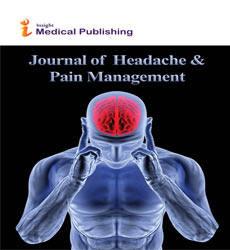P53 and HIC1 in Brain Cancer Gliomas
Sanjay Kumar
DOI10.4172/2472-1913.100018
Sanjay Kumar*
Department of Biochemistry, Central University of Haryana, Mahendragarh, India
- Corresponding Author:
- Sanjay K
Assistant Professor and Head
Department of Biochemistry
Central University of Haryana, Mahendragarh, India
Tel: 407-266-7001
E-mail: Sanjay.Kumar@ucf.edu
Received date: May 19, 2016; Accepted date: May 20, 2016; Published date: May 24, 2016
Citation: Sanjay K. P53 and HIC1 in Brain Cancer Gliomas. J Headache Pain Manag. 2016, 1:2.
Copyright: © 2016 Sanjay K. This is an open-access article distributed under the terms of the Creative Commons Attribution License, which permits unrestricted use, distribution, and reproduction in any medium, provided the original author and source are credited.
Editorial
Hypermethylated in Cancer 1 (HIC1) is a novel tumor suppressor gene (TSG) which acts as a transcriptional enhancer and growth obliterator, identified by Baylin et al. more than 10 years back. HIC1 is found to be methylated in varieties of human cancers as seen in ductal carcinoma of the breast wherein promoter methylation and allelic loss of 17p13.3 chromosomal locus has been reported without any significant mutation in p53 gene. To determine the targets, Zhang et al. reported that Ephrin-A1 is one potential target for the TSG role of HIC1 in breast cancer cells. The region 17p13.3 consists of Variable Number of Tandem Repeats (VNTR) microsatellite markers such as YNZ22/D17S5/D17S30 and show intermittent DNA hypermethylation in neural cancer, colon cancer and lung cancer. Epigenetic silencing also is very commonly observed in liver cancer, breast cancer, gastric cancer, prostate cancer and is also seen in human male nonseminomatous germ cell tumors. The central coding domain of HIC1 exhibits elevated and eminent level of methylation in acute myeloid leukemia. Our laboratory had showed that 17p13.3 was preferentially affected in high grade primary human gliomas and the same was associated with increased p53 immunopositivity and proliferation within a particular tumor grade. Both HIC1 and p53 are catalogued as tumor repressors, HIC1 practically comply with p53 in cells cultures in laboratory as well as in genetically modified transgenic animals to repress/supress tumors and have binding sites on their promoters. Since P53 has binding site onto the promoter of HIC1 it transcriptionally up-regulates its expression. In corroboration, our result did showed an increased expression of HIC1 with wild type p53 containing U87MG cells whereas less or no expression with mutated cell lines (U373MG) or null p53 (SaOS-2) (Sanjay et al.). The ambiguity was previously reported that wild type P53 continuously being formed and degraded by ubiquitination and proteasomal mediated pathway in absence of stress signal. On contrary, mutant forms of P53 are usually stable and escape degradation from ubiquitination pathway. We observed almost no expression of p53 in U87MG and SaOS-2 cells whereas U373MG showed high level of mutated p53. Conventionally HIC1 is a tumour suppressor gene (TSG), hence the over expression of this gene leads to arrest of cell cycle. Since HIC1 plays the role of TSG, the activities like cell cycle regulation and p53 dependency is not known. We have done a research on the activity of HIC1 in cell cycle as well as during glioma cell line (U87MG) proliferation, that had the wild type p53 gene in both serum containing and serum deprived medium. Reduction in number of cells and cell proliferation was revealed during HIC1 knocking as compared to control siRNA of cells without any treatment with serum containing medium and serum free medium. Flow cytometry and FacsDiva software verified the arrest of the cell cycle at the G2-M phase without any significant increase in the number of cell death i.e., cell apoptosis in both the medium. An increase in the expression of p53 gene associated with the knockdown of the HIC1 was seen. Moreover, we observed an increase in p21, p27 along with p53 gene when compared to the controls. The expression level of another cell cycle regulatory protein p27 found to be very significantly high comparing to controls. This could be the cause of arresting the cell cycle even after knocking down a tumor suppressor gene like HIC1, which was quite unexpected and beyond the convention. The results revealed the significance of HIC1 in the normal progression of cell cycle and also its activity the at molecular level, affecting the homeostasis of p53 gene as well as a number of genes, which are directly or indirectly related to p53, taking part in the cell cycle process.
Hence we conclude that p53 serves as a checkpoint during the cell cycle process determining anti-cancerous mechanisms recognizing DNA damage and plays a significant role in apoptosis, stability of genome and angiogenesis.
Open Access Journals
- Aquaculture & Veterinary Science
- Chemistry & Chemical Sciences
- Clinical Sciences
- Engineering
- General Science
- Genetics & Molecular Biology
- Health Care & Nursing
- Immunology & Microbiology
- Materials Science
- Mathematics & Physics
- Medical Sciences
- Neurology & Psychiatry
- Oncology & Cancer Science
- Pharmaceutical Sciences
